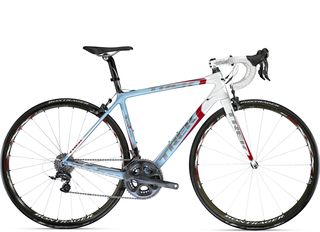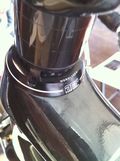gathered about 30 international cycling journalists in Rotterdam on Friday to introduce the 2011 Madone line of road bikes. Speaking in a meeting hall just off the route of Saturday’s Tour de France Prologue, Trek road product manager Tyler Pilger unveiled a Madone line that involves a new proprietary carbon composite for considerably lighter weights, a wider range of fit options, a new naming structure, and more customizability in the company’s Project 1 program.

The 6.9 SSL replaces the current 6.9 with a frameset that has exactly the same geometry and tube dimensions as the 2010 model—it’s built using the same molds—but is 100 grams lighter. Pilger claims production weight for a bare 56cm 6.9 SSL frameset is a shocking 815 grams, or more than 10 percent lighter than the 2010 model.

In simple terms, this means Trek’s engineers can use less to build virtually the exact same frame. Vertical compliance and lateral stiffness are unchanged over the current Madone, but ride quality gets snappier due to the reduced weight. (Think under 14 lbs for a complete, out-of-the-box bike.)
I got a two-hour ride on the 6.9 SSL today, on bike paths and farm roads outside of Rotterdam. I’ll need way more time on the bike for a full review (in a country with hills), but my first impression is that the bike rides virtually identically to the 2010 6.9 but feels noticeably lighter.
The SSL will be available starting today in either a 6.9 or 6.7 configuration. Both will have full Shimano Dura-Ace groups, but the 6.9 will have, in addition to the lightweight headset, top-end Bontrager Race XXX Lite carbon wheels, bars, and stem, versus a more familiar Cane Creek integrated headset and Race X Lite components on the 6.7. Still waiting for final pricing, but I’m told the 6.9 SSL will come in just south of $9.000, or well into superbike territory.
Trek has also change the naming and range of its fit options. The aggressive, race-ready Pro fit is now called H1, and the comfort-oriented Performance fit, which has a three-centimeter taller headtube, is now H2. Additionally, Trek has added a third fit option, based on its women’s-specific geometry, called H3. This will lengthen the headtube by an additional 1.5 to two centimeters and reduce top-tube length by about one centimeter.
While most of Trek’s pro racers choose the H1 geometry, Trek claims H2 is the ideal setup for about 75 percent of its customers and is even the preference of a few RadioShack pros, including 38-year-old Chris Horner. For those who need an even more upright position, H3 will ease back and neck strain with a geometry that was previously offered only as a women’s-specific option.
The Madone line is now divided into three families: 6 Series, 5 Series, and 4 Series. The 6.9 and 6.7 will be available in both H1 and H2 configurations, while the rest of the six series will be available in all three fit options. The 5 Series on down will offer only H2 and H3 fits.
The 5 Series is entirely new for 2011, offering 6 Series shapes and technology but with cheaper carbon layups and more price-conscious builds. Additionally, both the 5 and 6 Series bikes will be available through Trek’s Project 1 program, which offers fully customizable paint and build options.
The carbon 4 Series remains unchanged, save for new paint options and the new Shimano 105 5700 component group.
Prices will range from $8,708 for a complete Madone 6.9 SSL down to $2,100 for the 4.5.
A note on steerer tubes
Trek has reportedly received a few complaints over the past few weeks—noted last month by VeloNews.com—about the carbon steerer tubes on its top-end Madones shearing off. Trek claims this is due to incorrect installation and/or the use of incompatible handlebar stems, rather than a design flaw. Still, the company has added extra carbon fiber to its new steerer tubes and will also include a pre-set torque wrench with its Madones that have carbon steerers to facilitate proper stem installation.
—John Bradley
Twitter: